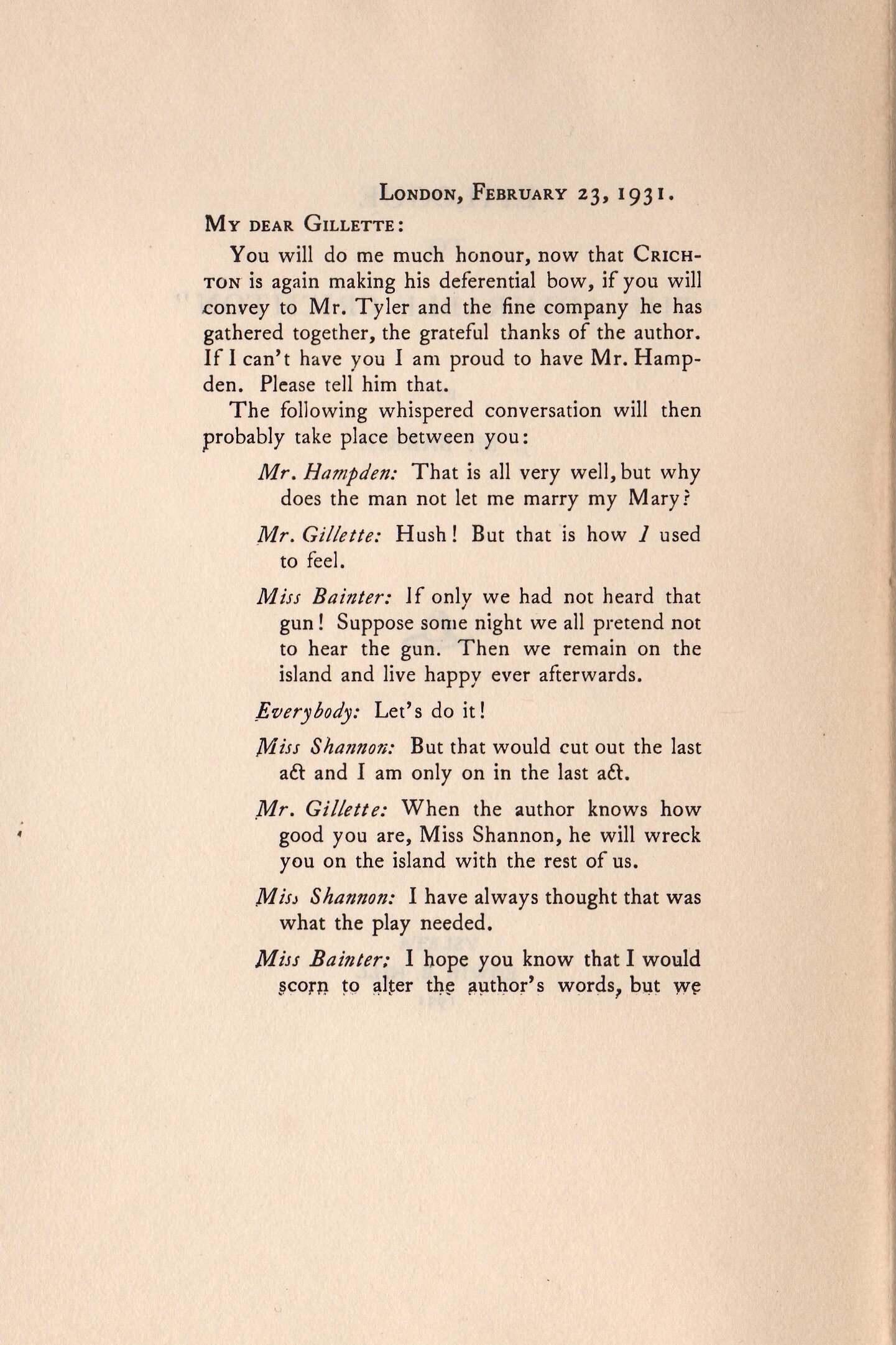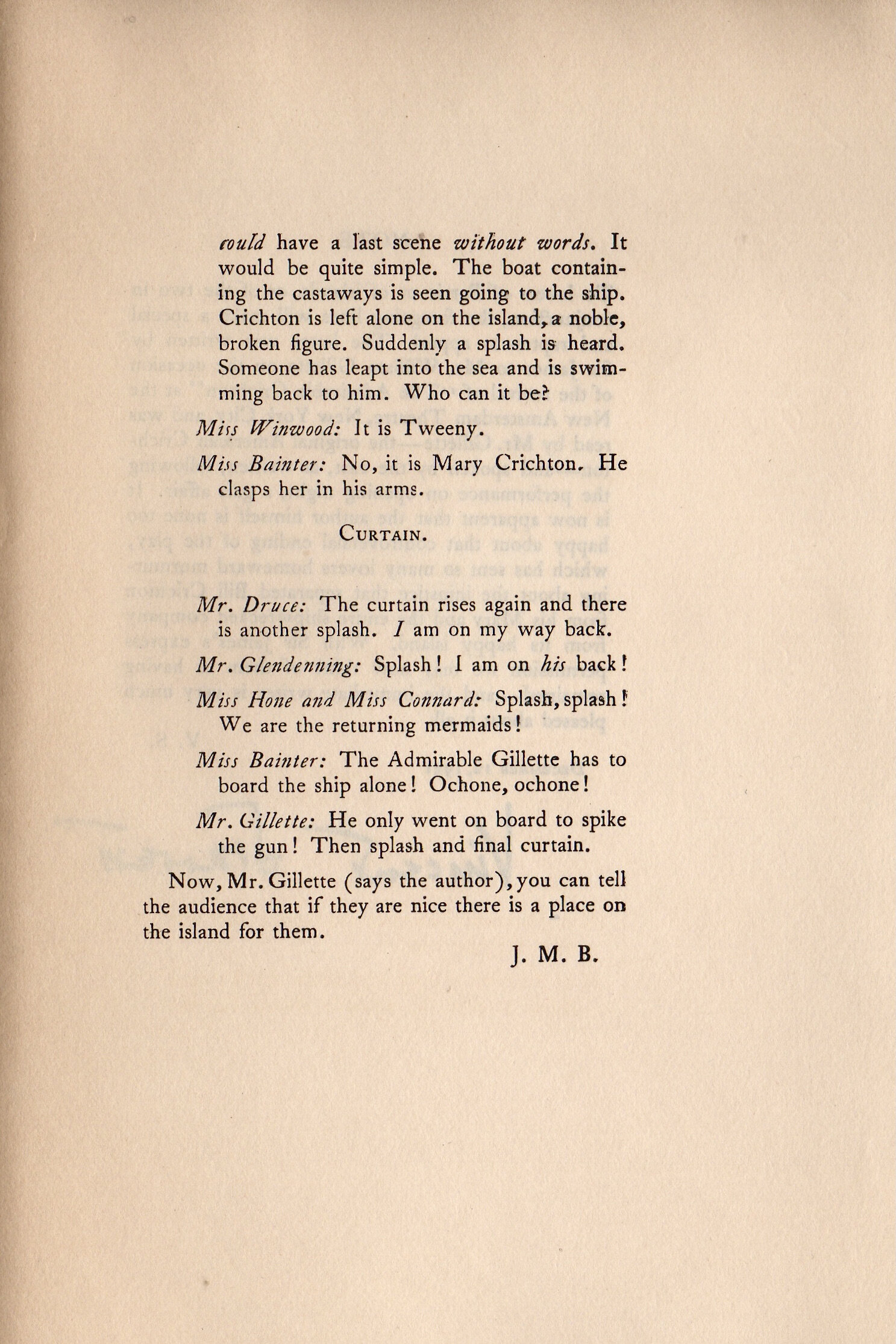William Gillette helps 'The Admirable Crichton' with a new ending
Starrett reprints J.M. Barrie's whimsical island rewrite
Faithful readers might recall the post from a while back about Edwin Bliss Hill and his little hand press.
Hill and Starrett were friends, and every once in a while the Chicago writer would send some lost or hard-to-find bit of literary whimsy to Ysleta, Texas for the printer to use in a limited edition leaflet. Many of the leaflets have Sherlockian interest. All are now collector’s items.
I’ve recently been able to acquire a 1931 leaflet, supposedly one of only 50 copies. And while it’s not strictly Sherlockian in nature, there are enough associated elements that I hoped you would enjoy taking a look.
But first, a little background.
Neverland was not the only island that J.M. Barrie wrote about.
Members of the original British cast, with H.B. Irving as the Earl of Loam at the center. (Printed in and scanned from "Lord Loam's Principles Claim No Adherence From Crichton", Play Pictorial, February 1903, p. 407.)
Among his most famous plays was “The Admirable Crichton,” which illustrated what happens when a group of aristocrats are stranded on a desert island. Only the butler, Crichton, is able to make himself useful. Indeed, he becomes the group’s leader and sets about establishing a livable village of sorts. Over time, the former servant becomes the impatient leader of the little colony, referred to as “The Gov” by other residents. His forceful actions win the heart of Lady Mary, daughter of the Earl of Loam.
While some in the group long for home, others come to enjoy their little tropical paradise, which lacks the artificial class structure of the late Victorian era. Lady Mary, Loam’s eldest daughter, was reluctantly betrothed to Lord Brocklehurst before being shipwrecked. Breaking all society barriers, Mary follows her heart instead and wants to marry the former butler Crichton on the island. But just before the two are pronounced husband and wife, the ceremony is cut short when the castaways hear a rescue ship’s gun in the distance. Had they remained silent, the ship would have sailed on without them. However, Crichton once again takes decisive action and fires a signal of their own. The group is rescued, and Crichton humbly resumes his role as a servant, losing the woman he loves.
Back home for the final act, the gentry feel uneasy around Crichton. They know he is the better man, but in London he is just a butler and no longer “The Gov.” A young aristocrat named Ernest Woolley, whom Crichton abused on the island for his laziness, produces a memoir of their island experience taking credit for their success.
The Earl of Loam’s three daughters from the original British cast. (Printed in and scanned from "Lord Loam's Principles Claim No Adherence From Crichton", Play Pictorial, February 1903, p. 407.)
While everyone knows it’s a lie, they cannot bring themselves to credit a servant with their survival. In the end, Crichton recognizes his ongoing presence is untenable and he does the admirable thing by leaving—without his beloved Mary. She will marry Lord Brocklehurst, thereby sustaining the family’s social status.
The ending is sad, but British audiences accepted it because it maintained a slowly fading way of life.
The play premiered in London on Nov. 4, 1902, and was an instant success, running for 828 performances.
The natural next move was to stage an American version.
But who would play the critical role of Crichton?
An advertisement from The New York Tribune for Nov. 15, 1903. The play was the first in the New Lyceum and was a hit. “Opening the New Lyceum Theatre in New York, the play and star were so enthusiastically received that they continue to fill the playhouse at every performance during the entire season without interruption,” said the Boston Evening Transcript for Oct. 27, 1904.
An American production, under the supervision of Charles Frohman, was prepared for 1903. Frohman and Barrie agreed that William Gillette would be perfect as the title character.
Gillette as the ‘Admirable Crichton’ during the original American run of the play. From the The New York Evening World News for Nov. 18, 1903.
But there was a problem: Gillette was planning to take the lead in a new production of “Hamlet.” Frohman and Barrie convinced Gillette that Crichton would be another star turn, like those in “Secret Service” and “Sherlock Holmes.” Gillette agreed, and the play was a Broadway hit—except for the ending.
It seems American audiences were distressed that the hero did not end up with his lady love, who was doomed to endure a loveless but “proper” marriage. Gillette understood their reactions. Remember that in the play “Sherlock Holmes,” the great detective winds up in a clinch with the rescued damsel, Alice Faulkner. This was Gillette’s invention as he felt the audience will be pleased with a more traditional happy ending. Whether he tried to convince Barrie to make the change, much as he requested that Arthur Conan Doyle allow Holmes to fall in love, I don’t know.
What we do know is that Barrie later agreed that he too wanted the lovers remain on their little island together.
It wasn’t until the play was revived nearly 30 years later that Barrie chose to comment on his own ending. The play was revived on Broadway in the spring of 1931, with Walter Hampden taking Gillette’s role as the admirable butler. Barrie secretly wrote a little playlet that was to be performed at the revival’s first performance.
Which brings us to Vincent Starrett.


Starrett doesn’t say how he got a copy of Barrie’s little playlet. We know Starrett corresponded with Gillette, and the actor himself could have been the source. It’s just as likely that Starrett cribbed it from the March 10, 1931 New York Times, which published it in full.
Here’s how it was performed at the end of the revival’s first performance.
With the cast of the new production assembled after the curtain call, Gillette came on stage to great applause. According to New York Daily News critic Burns Mantle, seeing the former star of the play surrounded by the new cast was the highlight of the evening.
Mantle wrote that Gillette “whose triumph it was in 1903-04, walked out on the stage after the last act and read a letter from Mr. Barrie that proved to be an added playlet itself.” Speaking to Walter Hampden, the two “Crichtons” agree they were unhappy with the ending. They discuss how they should have ignored the signal from the rescue boat, stayed on the island and married his love. The actor who played Mary, Miss Bainter, jumps on board with “Supposed one night we all pretend not to hear the gun. Then we remain on the island and live happy ever afterward.” Soon everyone in the cast agrees.
Mantle, in his Daily News column, said that Barrie promised “to save a place on the island for all good audiences.” He reports that those in the audience were delighted with the invitation.
In December of 1931, Starrett had 50 copies of the letter produced as a four-page holiday leaflet.
Starrett noted that “It is now apparent that the author himself is none too happy about that controversial ending of the play, which has sent so many lovers homeward murmuring about the injustice that separated Bill Crichton from his Mary and the entire shipwrecked company from its happy island. With Sir James’s express permission we may now think of them as having remained—and the immediate writer is very much pleased about it all.”
You can see the whole document by clicking on the images in this post.
(About that signature, I shall stay silent. For the moment.)
Before we sign off, I should note there is one other possible connection between this play and Sherlock Holmes. There is a claim that a remark by Arthur Conan Doyle inspired Barrie’s play. According to the The Guardian: “The seed of this JM Barrie upstairs-downstairs drama was planted by Arthur Conan Doyle's observation that ‘if a king and an able seaman were to be wrecked together on a desert island, the sailor would end as king and the monarch as servant’."
So you see, there is a Sherlockian connection after all.


